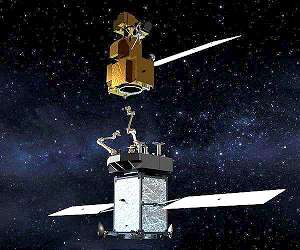ATLAS expands on-orbit customer base, bolsters global ground network
ATLAS Space Operations, a leading innovator of ground communications in the space industry, continues to grow its on-orbit customer base with two additional launches this past week. BlackSky Global’s Global-3 and the National Oceanic and Atmospheric Administration’s (NOAA) COSMIC-2 both successfully launched into orbit, utilizing ATLAS for communications and data support.
ATLAS is tasked with providing ground station operations as well as telemetry, command, and data support for both BlackSky and NOAA’s newly deployed satellites. ATLAS will support the Low Earth Orbit (LEO) constellations via their global network of ground stations, including their four newest antennas located in: Sunyani, Ghana; Harmon, Guam; Tahiti, French Polynesia; Chitose, Japan.
“ATLAS is proud to be a key support element for all of our customers who have successfully deployed from these historic launches,” said Sean McDaniel, CEO and Co-Founder of ATLAS.
“We are committed to delivering valuable, low latency Earth imagery data for our BlackSky Global customers. We have been working with NOAA since early 2017 to build and test ground systems that are critical to the continuation of NOAA’s GPS Radio Occultation data collection mission via COSMIC-2. We share in the team’s excitement in achieving this much-anticipated milestone.”
NOAA successfully launched and deployed six satellites as a part of the June 25th, 2019 SpaceX Falcon Heavy launch from the Kennedy Space Center in Cape Canaveral, Florida. The Constellation Observing System for Meteorology (COSMIC-2) will orbit Earth collecting data for weather forecasting, climate monitoring and research space weather.
The six-satellite constellation will help to improve weather prediction models for years to come, and provide three times the data COSMIC-1 was able to capture.
BlackSky’s Global-3 launched out of Mahia Peninsula, New Zealand aboard Rocket Lab’s Electron launch vehicle as a part of the “Make it Rain” mission – a nod to the heavy precipitation in both Seattle and New Zealand.
A division of Spaceflight Industries, BlackSky is a leader in geospatial monitoring and alert services that help organizations observe and understand global events by integrating a diverse set of sensors and data, including satellite imagery.
Global-3 is part of a planned sixty-satellite constellation that will provide 1-meter resolution color imagery with frequent revisit rates of 95 percent of the Earth’s population.
The ATLAS network currently consists of thirty operational and planned antennas globally employing Freedom, a proprietary software platform that allows for seamless customer integration into the communication network while optimizing all mission critical components and providing automated pass scheduling.
The cloud-based software approach makes communicating with both commercial and U.S. civil spacecraft simpler and more cost effective by reducing capital expenditures at every ground entry point.
Related Links
Enter ATLAS Space Operations
Space Technology News – Applications and Research
|
We need your help. The SpaceDaily news network continues to grow but revenues have never been harder to maintain. With the rise of Ad Blockers, and Facebook – our traditional revenue sources via quality network advertising continues to decline. And unlike so many other news sites, we don’t have a paywall – with those annoying usernames and passwords. Our news coverage takes time and effort to publish 365 days a year. If you find our news sites informative and useful then please consider becoming a regular supporter or for now make a one off contribution. |
||
|
SpaceDaily Contributor $5 Billed Once credit card or paypal |
SpaceDaily Monthly Supporter $5 Billed Monthly paypal only |
|

![]()
Compliant space mechanisms
Bethesda MD (SPX) Jun 18, 2019
Compliant mechanisms are flexible devices that transfer input forces and displacements to an output force and displacement at another location through elastic body deformation. In other words, these are monolithic (single piece) or jointless structures.
Thus, there is no need for assembly. And, with no joints there is no rubbing or friction between two parts, unlike the traditional rigid body mechanisms that have joints.
Compliant mechanisms are elastic and usually designed using special tec … read more
